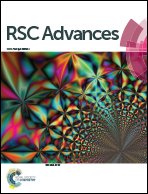Template-assisted self-assembly of diblock copolymer micelles for non-hexagonal arrays of Au nanoparticles†
Abstract
We report the construction of non-hexagonal arrays of nanoparticles by the template-assisted self-assembly of polystyrene-block-poly(4-vinylpyridine) copolymer micelles. Diblock copolymers were spin-coated onto nanoscale TiO2 templates, which successfully guided the placement of the micelles to form unconventional assemblies such as linear, zigzag, and Kagome array structures. These arrangements, different from the usual quasi-hexagonal arrays of copolymer micelles spin-coated onto a flat substrate, greatly depend on the physical dimensions of both the template and the micelles. Subsequent treatment of the copolymer micelle assemblies with oxygen plasma resulted in various non-hexagonal arrays of Au nanoparticles while preserving the arrangement of the original micelles on the template.


 Please wait while we load your content...
Please wait while we load your content...